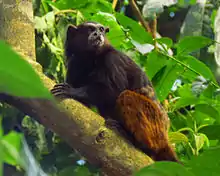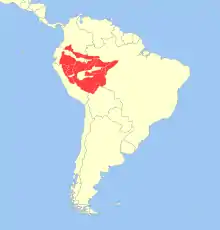Brown-mantled tamarin
The brown-mantled tamarin (Leontocebus fuscicollis), also known as Spix's saddle-back tamarin, is a species of saddle-back tamarin from South America. It is found in Bolivia, Brazil and Peru.[4][5]
| Brown-mantled tamarin[1][2] | |
|---|---|
 | |
| In Tambopata Park | |
| Scientific classification | |
| Kingdom: | Animalia |
| Phylum: | Chordata |
| Class: | Mammalia |
| Order: | Primates |
| Suborder: | Haplorhini |
| Infraorder: | Simiiformes |
| Family: | Callitrichidae |
| Genus: | Leontocebus |
| Species: | L. fuscicollis |
| Binomial name | |
| Leontocebus fuscicollis (Spix, 1823) | |
 | |
| Geographic range | |
The brown-mantled tamarin is sympatric with the pygmy marmoset, sharing the same habitat in South American counties, and will often raid the gum holes of this species.[6] It sometimes associates with the red-bellied tamarin.[5]
Brown-mantled tamarins occupy an extensive area of northern Amazonia.[7]
- L. f. avilapiresi, Avila Pires' saddle-back tamarin
- L. f. fuscicollis, Spix's saddle-back tamarin
- L. f. mura, Mura's saddleback tamarin
- L. f. primitivus, Lako's saddleback tamarin
Cruz Lima's saddle-back tamarin, Lesson's saddle-back tamarin, Illiger's saddle-back tamarin, the red-mantle saddle-back tamarin, the Andean saddle-back tamarin, Geoffroy's saddle-back tamarin and Weddell's saddle-back tamarin were all formerly considered subspecies of the brown-mantled tamarin.[4]
References
| Wikispecies has information related to Brown-mantled Tamarin. |
| Wikimedia Commons has media related to Brown-mantled Tamarin. |
- Groves, C. P. (2005). Wilson, D. E.; Reeder, D. M. (eds.). Mammal Species of the World: A Taxonomic and Geographic Reference (3rd ed.). Baltimore: Johns Hopkins University Press. p. 134. ISBN 0-801-88221-4. OCLC 62265494.
- Rylands AB, Mittermeier RA (2009). "The Diversity of the New World Primates (Platyrrhini)". In Garber PA, Estrada A, Bicca-Marques JC, Heymann EW, Strier KB (eds.). South American Primates: Comparative Perspectives in the Study of Behavior, Ecology, and Conservation. Springer. pp. 23–54. ISBN 978-0-387-78704-6.
- Rylands, A. B. & Mittermeier, R. A. (2008). "Saguinus fuscicollis". IUCN Red List of Threatened Species. 2008: e.T39947A10295229. doi:10.2305/IUCN.UK.2008.RLTS.T39947A10295229.en.
- Rylands, Anthony B.; Eckhard W. Heymann; Jessica Lynch Alfaro; Janet C. Buckner; Christian Roos; Christian Matauschek; Jean P. Boubli; Ricardo Sampaio; and Russell A. Mittermeier (2016). "Taxonomic Review of the New World Tamarins (Primates: Callitrichidae)" (PDF). Zoological Journal of the Linnean Society. 177 (4): 1003–1028. doi:10.1111/zoj.12386. Retrieved 2020-04-19.CS1 maint: uses authors parameter (link)
- Porter, Leila M.; Dacier, Anand; Garber, Paul A.; van Roosmalen, Marc (2016). Rowe, Noel; Myers, Marc (eds.). All the World's Primates. Pogonias Press. pp. 332–333. ISBN 9781940496061.
- de la Torre, S. & Rylands, A. B. (2008). "Cebuella pygmaea". IUCN Red List of Threatened Species. 2008: e.T41535A10493764. doi:10.2305/IUCN.UK.2008.RLTS.T41535A10493764.en.
- Mittermeier, Russell A; Nagle, C. A; Dixson, Alan F.; Epple, Gisela; Dukelow, W. Richard; Hearn, John P. (1983). Reproduction in New World Primates: New Models in Medical Science. Springer Netherlands. p. 12. ISBN 978-94-009-7322-0.
Further reading
- Dunbar (1995). "The mating system of callitrichid primates: II. The impact of helpers." Animal Behaviour, 50: 1071–1089.
- Goldizen (1987). "Facultative polyandry and the role of infant-carrying in wild saddle-back tamarins (Saguinus fuscicollis)." Behavioral Ecology and Sociobiology, 20: 99-109.
- Goldizen (1989). Social relationships in a cooperative polyandrous group of tamarins (Saguinus fuscicollis). Behavioral Ecology and Sociobiology, 24: 79–89.
Lüffe, T.M., Tirado Herrera, E.R., Nadjafzadeh, M. et al. Seasonal variation and an “outbreak” of frog predation by tamarins. Primates 59, 549–552 (2018).
